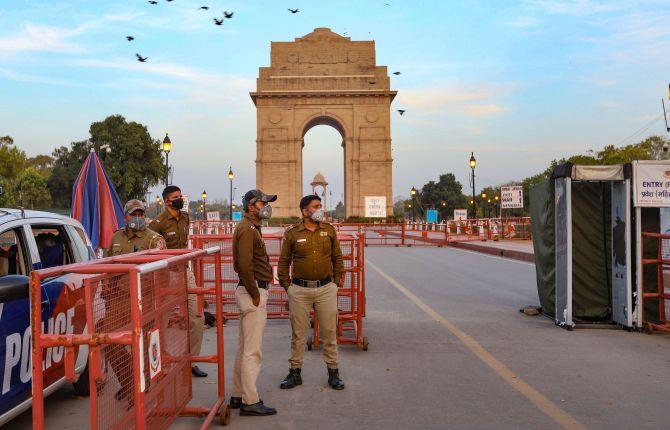With very few vehicles on roads, only essential commercial units functioning due to the coronavirus-forced lockdown and a weather favourable for dispersion of pollutants, the Central Pollution Control Board (CPCB) has reported 46 per cent reduction in PM2.5 levels and 50 per cent depletion in PM10 concentrations in the national capital.

The apex pollution control body has analysed data from continuous ambient air quality monitoring network of 38 stations in Delhi between March 16 and April 15.
Air quality trends have been studied in two phases -- pre-lockdown phase of March 16 to 21 and the lockdown phase from March 25 to April 15.
In its report, the CPCB said, 'Significant reduction in PM2.5, PM10 and NO2 levels observed. Overall, 46 per cent reduction in PM2.5 and 50 per cent reduction in PM10 concentration observed during the lockdown period.'
PM2.5 refers to particulate matter having diameter less than 2.5 micrometers which can enter the lungs and even the bloodstream.
The CPCB said reduction in PM10 and PM2.5 levels primarily indicate depletion in combustion and industrial sources of pollution which are common to both fractions of particulate matter.
Since 81 per cent of Delhi's nitrogen oxide comes from the transport sector, according to TERI Emission Inventory, 2018, restrictions on vehicular activity led to 56 per cent reduction in NO2 levels and over 37 per cent cut in carbon monoxide (CO) concentration during the lockdown period, compared to the pre-lockdown period, it said.
Due to restrictions on the transport sector and industrial operations, the two major sources of benzene emissions, a 47 per cent reduction in benzene level has been observed, the CPCB report stated.
'However, only 19 per cent reduction was seen in sulphur dioxide levels which may be due to the fact that over 70 per cent of Delhi's SO2 originates from power plants located around the national capital (as per TERI Emission Inventory, 2018) and power plants were operational during the lockdown period,' it added.
Since most of the eateries and industries in Delhi have shifted from coal to other less polluting energy sources, power plants appear to be the most likely source of sulphur dioxide.
The CPCB also analysed data from 13 pollution hotspots in Delhi.
Anand Vihar recorded 62 per cent, 69 per cent and 72 per cent reduction in PM2.5, PM10 and NO2 levels respectively during the lockdown period, the report said, adding Vivek Vihar, which is near major traffic corridor GT Road, saw a 60 per cent reduction in NO2 levels.
In Dwarka Sector-8, PM2.5, PM10 and NO2 levels depleted by 48 per cent, 61 per cent and 68 per cent respectively, while Okhla recorded a 72 per cent reduction in nitrogen dioxide levels, the CPCB said.
The apex pollution control body recorded 24 hourly average PM2.5 and PM10 levels within National Ambient Air Quality Standards (NAAQS) for 20 and 15 days respectively in 22 days of the lockdown period. NO2 levels were 75 per cent less than their 24 hourly standard.
24-hour averages of PM10, PM2.5, NO2 and SO2 levels dropped as low as 24 microgrammes per cubic meter, 39 µg/m3, 15 µg/m3 and 10 µg/m3 respectively during the lockdown period, the report said.
A 27 per cent increase in PM2.5 level and a 65 per cent increase in PM10 concentration was observed in between April 7 to April 15 compared to the first two weeks of the lockdown -- March 25 to April 6.
However, the CPCB said, PM2.5 and PM10 levels were still lower by 39 per cent and 35 per cent respectively than pre-lockdown concentrations. This may primarily be attributed to change in meteorological conditions.
The onset of summers has led to dry and dusty conditions. A mild dust storm from the western part of the country and the gulf region hit Delhi on April 14-15 rapidly increasing PM10 levels in Delhi and NCR, the pollution control body said.










